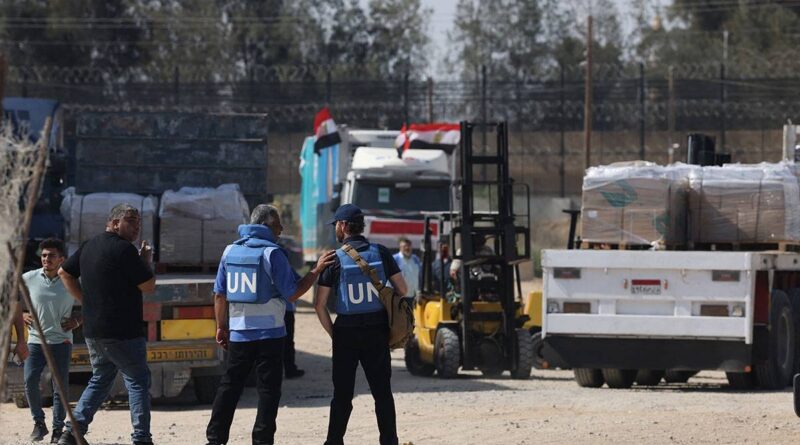Aid rolls into Gaza as border crossing opens
(UPDATE) TRUCKS carrying humanitarian aid for war-torn and besieged Gaza started passing into the Rafah border crossing from Egypt Saturday, a security source and an Egyptian Red Crescent official told Agence France-Presse (AFP).
More than 200 trucks carrying roughly 3,000 tons of aid had been positioned near the crossing for days. But Egypt’s state-owned Al-Qahera news, which is close to security agencies, said just 20 trucks had crossed into Gaza on the 15th day of the war between Israel and Hamas, the militant movement which rules the Palestinian enclave of 2.4 million people.
HELP HAS COME The first of 20 trucks carrying humanitarian aid enter the war-torn and besieged Gaza Strip from Egypt via the Rafah border crossing on Friday, Oct. 21, 2023, as United Nations Aid workers gather to meet them. AFP PHOTO
Hundreds of foreign passport holders also waited to cross from Gaza to Egypt to escape the conflict.
An AFP journalist on the Palestinian side of the crossing saw 36 empty trailers entering the terminal and heading toward the Egyptian side, where they were to be loaded with the incoming aid.
Four ambulances, two UN vehicles and two Red Cross vehicles were also seen heading into the terminal.
Cargo planes and trucks have been bringing humanitarian aid to the Egyptian side of Rafah for days, but so far none has been delivered to Gaza.
Generators in Shifa Hospital, Gaza’s largest, were operating at the lowest setting to conserve fuel while providing power to vital departments such as intensive care, hospital director Mohammed Abu Selmia said. Others worked in darkness. The lack of medical supplies and water makes it difficult to treat the mass of victims from the Israeli strikes, he said.
The Palestine Red Crescent Society said it had received a threat from the Israeli military to bomb Al-Quds Hospital. It said Israel has demanded the immediate evacuation of the Gaza City hospital, which has more than 400 patients and thousands of displaced civilians who sought refuge on its grounds.
It was not clear if there was an agreement for generator fuel to be brought in through Rafah.
The Hamas-run government in Gaza said the limited convoy “will not be able to change the humanitarian catastrophe that Gaza is currently enduring,” calling for a secure corridor operating around the clock.
Israel has been bombing Gaza since Hamas’ bloody surprise attack of October 7.
The Islamist group stormed into Israel from the Gaza Strip and killed at least 1,400 people, mostly civilians who were shot, mutilated or burned to death on the first day of the raid, according to Israeli officials, also taking more than 200 people hostage.
Israel has declared a total siege on Gaza and cut off supplies of water, electricity, fuel and food, creating chronic shortages.
Rafah is the only route into Gaza that is not controlled by Israel, which agreed to allow aid in from Egypt following a request from its top ally, the United States.
UN Secretary-General Antonio Guterres on Friday visited the Egyptian side of the crossing to oversee preparations for the aid delivery.
“These trucks are not just trucks; they are a lifeline,” he said.
“They are the difference between life and death for so many people in Gaza.”
The opening came after more than a week of high-level diplomacy by various mediators, including visits to the region by US President Joe Biden and Guterres.
Israel had insisted that nothing would enter Gaza until some 200 people captured by Hamas were freed, and the Palestinian side of the crossing had been shut down by Israeli airstrikes.
The opening came hours after Hamas released an American woman and her teenage daughter, the first captives to be freed after the militant group’s October 7 incursion into Israel. It was not immediately clear if there was any connection between the two.
Hamas released Judith Raanan and her 17-year-old daughter, Natalie, on Friday for what it said were humanitarian reasons in an agreement with Qatar, a Persian Gulf nation that has often served as a Mideast mediator.
Hamas said in a statement that it was working with mediators “to close the case” of hostages if security circumstances permit. The group said it is committed to mediation efforts by Egypt, Qatar and others.
There are growing expectations of a ground offensive that Israel says would be aimed at rooting out Hamas, an Islamic militant group that has ruled Gaza for 16 years. Israel said Friday it does not plan to take long-term control over the small but densely-populated Palestinian territory.
Israel has also traded fire along its northern border with Lebanon’s Hezbollah militant group, raising concerns about a second front opening up. The Israeli military said Saturday it struck Hezbollah targets in Lebanon in response to recent rocket launches and attacks with anti-tank missiles.
Israel issued a travel warning on Saturday, ordering its citizens to leave Egypt and Jordan — which made peace with it decades ago — and to avoid travel to a number of Arab and Muslim countries, including the United Arab Emirates, Morocco and Bahrain, which forged diplomatic ties with Israel in 2020. Protests against Israel’s actions in Gaza have erupted across the region.
A potential Israeli ground assault is likely to lead to a dramatic escalation in casualties on both sides in urban fighting. More than 1,400 people in Israel have been killed in the war — mostly civilians slain during the Hamas incursion. Palestinian militants have continued to launch unrelenting rocket attacks into Israel — more than 6,900 projectiles since October 7, according to Israel.
More than 4,100 people have been killed in Gaza, according to the Health Ministry run by Hamas. That includes a disputed number of people who died in a hospital explosion earlier this week.
Speaking Friday about Israel’s long-term plans for Gaza, Defense Minister Yoav Gallant laid out a three-stage plan that seemed to suggest Israel did not intend to reoccupy the territory it left in 2005.
First, Israeli airstrikes and “maneuvering” — a presumed reference to a ground attack — would aim to root out Hamas. Next will come a lower-intensity fight to defeat the remaining pockets of resistance. And, finally, a new “security regime” will be created in Gaza along with “the removal of Israel’s responsibility for life in the Gaza Strip,” Gallant said.
Gallant did not say who Israel expected to run Gaza if Hamas is toppled or what the new security regime would entail.
Israel occupied Gaza from 1967 until 2005, when it pulled up settlements and withdrew soldiers. Two years later, Hamas took over. Some Israelis blame the withdrawal from Gaza for the five wars and countless smaller exchanges of fire since then.




